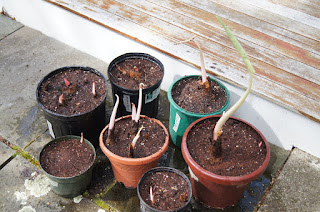 |
| Salvia guaranitica 'Black and Blue' |
They’re plants from warmer latitudes that can’t tolerate New England winters outdoors. Because of their large fleshy roots, they can survive out of the ground until spring.
 |
| Dahlia tubers after a winter in the basement |
Making this happen is supposed to be more complicated than I’ve found it. For example, my old copy of The Reader’s Digest Illustrated Guide to Gardening prescribes many steps for winter storage of dahlia tubers. The reader is instructed to wait until frost blackens the foliage, cut off stems at 6 inches, carefully lift the roots from the soil without damaging them, use a blunt stick to clear loose soil from the tubers, hang the plants upside down for two weeks to dry, dust them with sulfur to prevent fungal infections, and store them in trays of dry sand or peat moss in a cool greenhouse or dry cellar at 40 to 45 degrees.
This idea that houses contain rooms or outbuildings that stay at 40 to 45 degrees during the winter seems to be a throwback to English gardening. With central heating and effective insulation, I can’t imagine there are many houses in the northeastern US that offer these special conditions for plant storage.
I tried the Reader’s Digest authors’ approach one winter (admittedly leaving out the sulfur sprinkling). By spring my tubers had dried up, shriveled and died.
Instead, I stumbled on a much simpler approach for over-wintering tender perennials. In late fall I cut the stems and dig up the plant, leaving plenty of soil around the roots. I place each plant, soil and all, in a brown paper grocery bag. I enclose this in a plastic drawstring kitchen-size trash bag, tie the top closed, and store it in the basement on wire shelving. There the plants go dormant in darkness and cool-enough temperatures.
Cultivating dahlias for the biggest, showiest flowers is a special skill that I haven’t acquired. However, I can count on my stored dahlia tubers and other tender perennials to stay hydrated enough to sprout indoors when I replant them in pots in May. I let them grow indoors for a month.
 |
| Potted and ready to go inside to sprout in a sunny spot |
As the weather warms, I move them outdoors during the day and back inside at night. After Memorial Day I can plant them in the garden or in large containers, where they flower again for another summer.
 |
| Elephant ears in July |
 |
| Dahlias in September |
I used to consume many bags of commercial potting mix for this process. Now I get good results with a peat-free mix of half coir (coconut fiber) and half screened compost from my compost piles. I’m glad to leave the peat in its bogs, where it sequesters carbon.
 |
| I mix screened compost and coir right where I'll pot the stored plants |
No comments:
Post a Comment